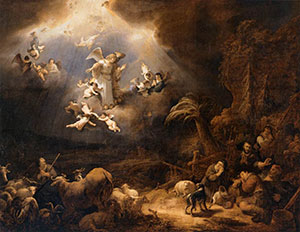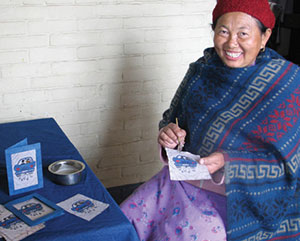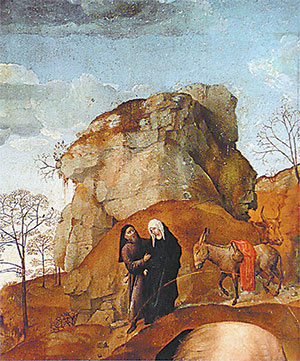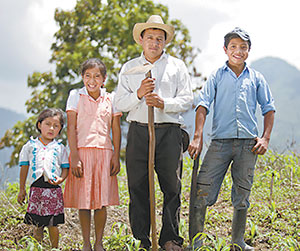 Editor’s note: The Catholic News Herald offers these Advent reflections courtesy of Catholic Relief Services. These Advent reflections, activities and prayers invite us to prepare our hearts to welcome Emmanuel, “God with us” (Matthew 1:23), into our world at Christmas.
Editor’s note: The Catholic News Herald offers these Advent reflections courtesy of Catholic Relief Services. These Advent reflections, activities and prayers invite us to prepare our hearts to welcome Emmanuel, “God with us” (Matthew 1:23), into our world at Christmas.
There is a Light in this World Loving Jesus,
Loving Jesus,
In Your name, we mark this season:
As we bring forth light to defy the claims of darkness,
As we bring forth joy and song to defy the claims of sadness,
As we bring forth a spirit of generosity to defy the claims of want,
As we bring forth peace to defy the claims of war.
That in the darkest, saddest, most wanting, warring corner of the world,
All may look to Bethlehem
Where, in the humblest of circumstances,
In a time of repression
From the person of a poor refugee woman
In the filth of a manger
In the form of a most vulnerable child
You came among us to say, “No, there is a light in this world.”
Let us be this light to others.
Let us be the fruit of the branch of Jesse’s tree.
Let us be the bearers of the indescribable gift that is Your grace.
And so defy all false claims on Your people and their dignity.
And so, may You be born anew, into every season
Into every age
Into every land and every human heart.
Maranatha! Come, Lord Jesus, come.
Amen.
PRAY Photo courtesy of Ten Thousand VillagesLoving God, like Elizabeth,
Photo courtesy of Ten Thousand VillagesLoving God, like Elizabeth,
who recognized Jesus in Mary,
we pray that we may recognize
Jesus in others, especially in
those who are suffering and
most in need. Amen.
REFLECT
Who in your life is most often left out? Why do you think that is? What can you do to include them?
ACT
This week, try to recognize the presence of Jesus in people who are sick. Think of someone you know who is sick – and reach out to him or her today.
GIVE
Buy a gift that supports people like Basu – and people who have been affected by natural disasters around the world. Visit ethicaltrade.crs.org.
 LIGHT THE ADVENT WREATH
LIGHT THE ADVENT WREATH
In the name of the Father, and of the Son, and of the Holy Spirit … Come Lord Jesus, be our light! Help us to recognize You in others.
READ THE GOSPEL
Fourth Sunday of Advent (Cycle C): Luke 1:39-45
“And how does this happen to me, that the mother of my Lord should come to me?”
REFLECT WITH A STORY
In this Gospel reading, Mary travels to see her cousin Elizabeth, who is pregnant with John the Baptist. When Elizabeth sees Mary, John the Baptist leaps within her. Elizabeth immediately knows this is because Mary is carrying Jesus, the son of God, in her womb. Nobody expected that Mary – a lowly Nazarene woman – would be the person to bring the Messiah into the world. And yet Elizabeth recognizes Jesus in her. We can still recognize Jesus in our world today. He tells us that whatever we do for those who are suffering and in need, we do for Him (Matthew 25:40). But it can be difficult to recognize Jesus in others – especially in those who are suffering or left out.
In Nepal, which suffered a devastating earthquake in April 2015, many people live in poor conditions. And many people like Basu Dev Dahal struggle with infectious diseases like leprosy. Leprosy is a disease that can permanently leave people with discolored skin and deformed limbs. When Basu first developed leprosy, he wasn’t welcome in his family or community because of the stigma attached to the disease. He received treatment and was cured, but he was left with deformed fingers.
The Nepal Leprosy Trust is an organization that hires people with leprosy. Like Elizabeth recognized Jesus in Mary, the staff at the Nepal Leprosy Trust recognize Christ in people often rejected by society.
Despite his deformed fingers, Basu began working in the leather goods workshop of the trust – he even became the supervisor! He was soon able to buy a home and provide for his wife and three sons.
 Editor’s note: Starting this week, the Catholic News Herald offers these Advent reflections courtesy of Catholic Relief Services. These Advent reflections, activities and prayers invite us to prepare our hearts to welcome Emmanuel, “God with us” (Matthew 1:23), into our world at Christmas.
Editor’s note: Starting this week, the Catholic News Herald offers these Advent reflections courtesy of Catholic Relief Services. These Advent reflections, activities and prayers invite us to prepare our hearts to welcome Emmanuel, “God with us” (Matthew 1:23), into our world at Christmas.
These weekly reflections, based on the Gospel readings for each Sunday in Advent, connect the journey that brought Mary and Joseph to the stable with the journey of all those communities around the world that continue to encounter poverty.
At www.crs.org: More resources for your Advent journey, including videos, prayers and even a “digital Advent retreat”
 “The Census at Bethlehem,” by Pieter Bruegel the Elder (1566). Set in a snowy, winter scene inspired by his native Flanders, Pieter Bruegel the Elder depicts Mary and Joseph (pictured in the foreground, with Mary riding a donkey) on their way to be registered in a census ordered by the Romans. Bruegel had a tendency to depict biblical events in a contemporary and local setting, which this painting illustrates perfectly. This painting is on display at the Royal Museums of Fine Arts in Brussels, Belgium.
“The Census at Bethlehem,” by Pieter Bruegel the Elder (1566). Set in a snowy, winter scene inspired by his native Flanders, Pieter Bruegel the Elder depicts Mary and Joseph (pictured in the foreground, with Mary riding a donkey) on their way to be registered in a census ordered by the Romans. Bruegel had a tendency to depict biblical events in a contemporary and local setting, which this painting illustrates perfectly. This painting is on display at the Royal Museums of Fine Arts in Brussels, Belgium.
Gracious Lord, Child of Bethlehem
Gracious Lord, Child of Bethlehem,
As You were born into a family who fled to Egypt as refugees, help us grow in solidarity with refugees everywhere, to know we are all refugees, until our hearts find refuge in You.
As You were born under an oppressive regime, let us grow in solidarity with those whose governments deny them their rights and try to undermine their dignity.
Help us work for just governance everywhere.
As it was workers, the shepherds, who first came to know You, the carpenter’s son, let us remember the dignity of human labor – that You share a special love for those who work hard for their sustenance, and toil beside them.
Let us honor You, in work and in prayer, that livelihoods may be secure, and that workers not be exploited.
As You were adored by the Magi who came from far-off nations to honor You, let us bring to all nations the great good news that is Your love.
As Your coming was joyfully sung by angels, let us with joy celebrate the gift of life every time a child of God is conceived, and honor that gift with our care.
As You were denied any birthplace but a stable, help us to open our homes, our lives, our hearts to the coming of God and His presence in Your people.
Be born this time into our hearts, dear Lord. Gracious Lord, Child of Bethlehem, through the cradle of our hearts, be born into our world.
Amen.
Advent wreath prayer
All gather around the Advent wreath:
LEADER: In the name of the Father, and of the Son and of the Holy Spirit.
Christ Jesus,
During these 4 weeks of Advent, we reflect on how we can prepare our hearts to better follow You. We pray that Your light guides us, especially in moments of darkness. We pray, too, for those around the world who struggle on their own journeys, wherever they live. Each week, as we light another candle on the wreath and approach the celebration of Christmas, let us remember that You are the light of the world, that You lead all people on their journeys and that You bring all people from darkness into light.
ALL: Christ, let Your light guide all those who journey. Light the appropriate candle(s).
READER: A reading from the Gospel of Luke (2:1-5)
In those days a decree went out from Caesar Augustus that the whole world should be enrolled. This was the first enrollment, when Quirinius was governor of Syria. So all went to be enrolled, each to his own town. And Joseph, too, went up from Galilee from the town of Nazareth to Judea, to the city of David that is called Bethlehem, because he was of the house and family of David, to be enrolled with Mary, his betrothed, who was with child.
The Gospel of the Lord.
ALL: Praise to you, Lord Jesus Christ.
LEADER: We hear in this reading that Mary and Joseph had to journey to Bethlehem to enroll in a census while Mary was pregnant. Like the Holy Family, who struggled on their journey to find a place for their child to be born, millions around the world also face challenging journeys. They are forced to leave their homes when violent conflict erupts without warning. Women may walk miles each day just to get water. Farmers must find new ways to support their families after a storm, drought or war destroys their crops.
ALL: Christ, let Your light guide all those who journey.
LEADER: Loving God, together with those around the world who struggle on their journeys, we gather around this wreath and pray with joyful hope that the light of Christ will illuminate our paths.
We praise you for the gift of Your Son, Jesus Christ, light of the world and hope of all nations.
We ask Your blessing throughout the Advent season for those of us gathered here and for those who journey throughout the world. We ask all this through Christ our Lord. Amen.
 “Mary and Joseph on the Way to Bethlehem,” by Hugo van der Goes (1475). Part of the Portinari Altarpiece on display at the Galleria degli Uffizi in Florence, Italy, it depicts Mary and Joseph traveling to Bethlehem. The Flemish artist illustrated Mary’s advanced pregnancy by depicting the aging Joseph carefully guiding his wife down the steep and rocky mountain.
“Mary and Joseph on the Way to Bethlehem,” by Hugo van der Goes (1475). Part of the Portinari Altarpiece on display at the Galleria degli Uffizi in Florence, Italy, it depicts Mary and Joseph traveling to Bethlehem. The Flemish artist illustrated Mary’s advanced pregnancy by depicting the aging Joseph carefully guiding his wife down the steep and rocky mountain.
PRAY
Lord, You call us to be watchful
because we do not know what
tomorrow may bring. We pray
that we may be ready to answer
Your call without delay and help
one another along the way. Amen.
REFLECT
Inez prepared for the future by recognizing God’s goodness in creation and caring for it. How do you care for God’s creation in your daily life?
ACT
This week, make a list of ways that you notice God’s goodness through creation.
GIVE
Care for creation and support farmers like Inez Ramirez. When you buy ethically produced coffee you help others care for creation.
Visit www.ethicaltrade.crs.org
 Photo by Oscar Leiva | Silverlight for CRSLIGHT THE ADVENT WREATH
Photo by Oscar Leiva | Silverlight for CRSLIGHT THE ADVENT WREATH
In the name of the Father, and of the Son, and of the Holy Spirit … Come Lord Jesus, be our light! Grant us eyes to recognize You as we wait and watch for You in the world around us.
READ THE GOSPEL
First Sunday of Advent (Cycle C): Luke 21:25-28, 34-36: “Be vigilant at all times and pray …”
REFLECT WITH A STORY
Jesus paints a frightening picture in this week’s Gospel: the sun, moon and stars are in dismay. The waves of the ocean are being tossed about. Even heaven is shaking! God’s very creation – the world in which we live and work – is trying to tell us something, and Jesus is encouraging us to pay attention. God reveals His greatness through creation; creation is beautiful and gives us what we need to live and to eat. But if we do not care for creation today, we may be in trouble in the future.
How do we care for God’s creation? In Guatemala, farmers like Inez Ramirez are working hard to care for plants, water and the soil that grows their crops. Like his father before him, Inez is a coffee farmer. But he is facing major challenges. His crops have contracted a fungus known as coffee leaf rust, which is destroying coffee crops across Central America. Despite losing half his crop, Inez is determined and hopeful. Just as Jesus calls us to “Be vigilant at all times and pray,” Inez remains watchful for opportunities and is eager to try new ways of farming. He and his brothers and parents are working through their challenges as one community. “We’ll figure out a way,” Inez says.
Inez sees God’s goodness in creation and takes care of it to help his family and future generations. Jesus also asks us to pay attention to how He is present in the world. We can show our love for Him and for others through the actions we take today.

